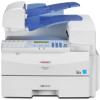Ricoh FAX3320L Facsimile Reference [Basic Features] - Page 45
Using Groups
 |
UPC - 026649305269
View all Ricoh FAX3320L manuals
Add to My Manuals
Save this manual to your list of manuals |
Page 45 highlights
Dialing C Press the {Speed Dial} key. Using Groups You can store multiple destinations as a single Group and simply specify a particular Group. You must store the destinations' fax number in a Group beforehand. 2 Additionally, you can store destina- tion names and a Group name in Groups. The method for specifying Groups differs according to the way they were programmed. D Enter the two digit code (00 to 99) for the destination with the number keys. Note ❒ When a name is stored for the destination, the name is displayed, and when no name is stored, the fax number is displayed. ❒ If you wish to dial another destination, press the {OK} key and dial another fax number. ❒ If you make a mistake, press the {Clear/Stop} key, and try again. • When programmed in a Quick Dial: Press the Quick Dial key. • When not programmed in a Quick Dial: Use the User Function Key. Group Dial is assigned to {F4} as a default setting. If this setting is changed, program the Group function in a User Function key ( {F1} to {F5} ). When you want to specify a destination, press the User Function key in which the Group Function is programmed, and then press the Group number with the number keys. See p.51 "User Function Keys", Advanced Features. Limitation ❒ You cannot use Immediate Transmission to send Groups. You can only use Memory Transmission. E Press the {Start} key. Note ❒ Quick Dials programmed for Groups cannot be used for any other function. ❒ To register, edit, or delete Groups, see p.59 "Groups" ❒ To check the contents of all Groups, print the Group Dial list. See p.54 "Printing Reports/Lists", Advanced Features. 39















